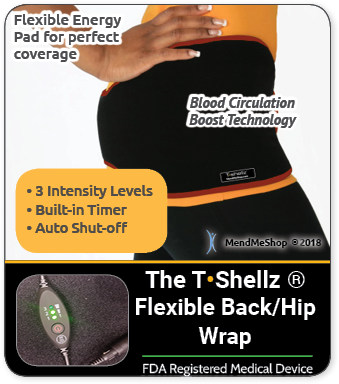|
| Hip Bursitis (Trochanteric/Iliopsoas Bursitis)Hip bursitis is a very painful condition in which a bursa sac inside of the hip becomes irritated and inflamed, affecting the bursa and the soft tissue around it. A bursa is a sac of synovial fluid, rich in protein and collagen that acts as a cushion to protect soft tissue, such as tendons, ligaments and muscle, from friction and excess pressure. 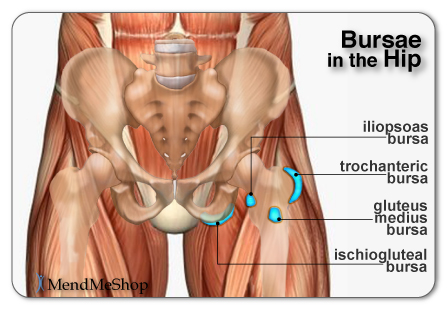 bursae = We have over 150 bursae in our bodies with most of them located in our joints. Bursae in the hip include the greater trochanteric bursa, deep trochanteric bursa, the iliopsoas bursa, gluteal medius bursa, ischiogluteal bursa, and ischial tuberosity bursa located in the back of the joint. The 3 most common types of hip bursitis occur in the greater trochanter bursa followed by the iliopsoas bursa and ischial bursa (also called the ischialgluteal bursa). Trochanteric BursitisThe trochanter bursa functions to prevent the iliotibial band (IT band) from rubbing against the greater trochanter of the femoral head. The IT band runs from the iliac crest (crest of the pelvis) down the side of the hip and leg, and inserts at the upper tibia (top of the knee.) It is mainly used along with the gluteus maximus for bracing the leg and knee when in the standing position. Trochanteric bursitis most often results from the iliotibial band (IT Band) tightening and rubbing against the bursa. The IT band is made up of thick, fibrous tissue that is considered connective tissue similar to a tendon. When it becomes irritated or inflamed, it can irritate the trochanter bursa causing inflammation within the bursa. Therefore, sufferers of iliotibial band syndrome (ITBS) may experience trochanteric bursitis at the same time. Trochanteric bursitis is often used as a general term to describe pain around the greater trochanteric region of the hip and is often confused with Greater Trochanter Pain Syndrome (GTPS). Trochanteric bursitis is ONE of many component that make up GTPS - the other notables relating to conditions that cause pain in the lateral side of the hip. Iliopsoas BursitisThe iliopsoas bursa lies between the front of the hip bone and the iliopsoas muscle, helping reduce friction between this bone and muscle. This bursa usually becomes inflamed due to overuse of the iliopsoas muscle. Overuse can tighten the muscle, causing more pressure on the bursa when the hip is flexed. Iliopsoas bursitis can be mistaken for tendinitis or hip arthritis because of the location of pain and other symptoms. Ischialgluteal BursitisThe ischial bursa is located at the bottom of the ischium (lower hip bone). It cushions the gluteus maximus muscle from the ischium when sitting on hard surfaces or when sitting for long periods of time. Ischial bursitis may cause back pain and due to the location, it is often mistaken for sciatica pain. General Information about BursitisImportant: In some cases, an inflamed bursa may become infected with bacteria (referred to as septic bursitis) and this can quickly become life threatening! In all cases where you suspect you may have bursitis, see a physician for full diagnosis. If the bursa is septic, getting to a doctor quickly may save your life. There are two types of bursitis: chronic and acute. Chronic bursitis is caused by overuse or repetition of a certain area or joint. It will develop over time, and will likely get better and flare up over a long period of time. Acute bursitis is often the result of a trauma to the hip, such as a fall. It can also result from a simple movement such as lifting and twisting the wrong way or may come on quickly following irritation during hip surgery. Some suffers cannot recall what triggered the hip pain, which is why some will not seek treatment, hoping it will resolve itself. However, it is always wise to address and treat hip pain as soon as possible so that the problem does not worsen. Hip Bursitis SymptomsA healthy trochanter bursa is usually about the size of a small plum, but can swell to the size of an orange when bursitis sets in. This is what creates the soft tissue damage in the area. Other symptoms you may experience include:
Hip Bursitis CausesBursitis of the Hip has been found to be statistically more prevalent in cases where the sufferer is involved in, or experiences one or more of the following factors: 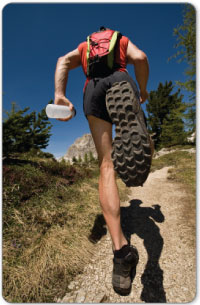
Treatments for Hip BursitisRelieving the symptoms of bursitis initially focuses on keeping the pressure off the bursa. Surgery may be required if your bursa irritation is a result of a bone formation problem, such as a bone spur. If your bursitis is caused by an infection (septic bursitis), the doctor will probably drain the bursa sac with a needle and prescribe antibiotics to treat the infection. For non-infectious bursitis, the preliminary treatment starts with non-operative options such as cold compression via use of a Cold Compress or Ice Pack. The most important factor in healing bursitis is resting your hip. This can be difficult when you have to carry on with daily activities, but resting whenever you can is recommended. During your recovery you will probably have to modify or avoid the activities that stress your bursa until your pain and inflammation settle. Treatments should involve decreasing swelling, relieving stress on the hip joint, correcting any bio-mechanical dysfunction (uneven leg length, bone spur, etc.), treating scar tissue, and then finally restoring strength and movement in your leg and hip. Circulatory Boost is recommended once inflammation has been calmed - this will maximize the potential of the body's natural ability to heal the bursa and surrounding tissue while helping reduce the risk of further irritation to the bursa due to inflammation or atrophy in the joint. Cold Compress or Ice Pack Cold TherapyTo decrease inflammation and relieve the pain of trochanteric bursitis doctor's recommend cold therapy. Applying cold to your inflamed bursa is the first step in treating bursitis - basically it gets the swelling down. TShellz Wrap®: Circulation Boost TechnologyOnce the inflammation of your bursitis has been reduced with cold therapy it is time to take the next step in bursitis treatment. Use a Back/Hip TShellz Wrap® to improve blood flow while simultaneously helping surrounding soft tissue to become elongated and more elastic. What this means is that not only is increased blood flow helping the bursa and surrounding soft tissue to heal, the tendons/muscles/ligaments that were rubbing on your bursa are now longer and more elastic. TShellz Wraps® are basically the perfect home bursitis treatment - helping reduce friction and rubbing on the bursa while maximizing blood flow in the area at the same time. Why Use a TShellz Wrap® For Your Hip?When a TShellz Wrap® is applied to the hip, veins will start to get bigger (expand) to allow more blood flow through to soft tissue. This in turn relaxes your hip, making the tissue more flexible and elastic. This is why heat is used on older (chronic) injuries, to loosen tissue and bring in the blood flow needed for healing. Your body will begin to heal itself after it is injured - in most cases, increasing your blood flow will speed up this natural process - often surprisingly well.  Doctors usually call this process 'Vasodilation'. When To Use a TShellz Wrap®A TShellz Wrap® temperature treatment works best to increase blood flow circulation and stimulate flexibility and elongation of soft tissue for older (chronic) injuries, re-injury (after swelling has been reduced) and during long-term post surgery recovery. Heat should not be started for a least 2 weeks after surgery because inflammation levels will be very high as the healing process starts over again. Any use of heat should also be combined with gradual movement to stretch out soft tissue in the hip and increase range of motion. If you have a chronic hip injury that keeps getting re-injured consider using heat before activity to loosen up your tissue (making it more flexible). When used at this time the warm temperatures naturally extend the elasticity (elastic-nature) of the joint, making it more movable / pliable for activity (this reduces risk of micro-tearing during activity). Sometimes we feel pain while doing a certain activity - should you still use heat? Using heat in the morning before you start your day or before activity can help to boost the healing process and reduce your risk of re-injury. Too much heat (especially when you suffer a set-back with swelling / inflammation) can make your inflammation worse. Cold treatments with a Cold Compress or Ice Pack should be used part-way through your day when you suffer from on-going pain and inflammation as a natural pain-reliever. Keep using Circulation Boost before activity and when you notice any stiffness in your hip to 'warm up' your muscles, tendons & ligaments. Click HERE to Go To Our Online Store We take all major credit cards and Paypal. Anti-Inflammatory Medications for BursitisNSAIDs, non-steroidal anti-inflammatory drugs, can be used if required to help manage your pain. However, these aren't recommended for long term use, as they can cause gastrointestinal difficulties and increase the risk of cardiovascular disease. The TShellz Wrap®, when used in conjunction with NSAIDs can greatly improve the effect of the medication; this can not only help you heal quickly but also reduce the amount of NSAIDs that you ultimately may require. Surgical Procedures for BursitisYour doctor may aspirate your inflamed bursa. This involves removing the extra fluid that has built up with a needle. Sometimes, the fluid will be tested at a laboratory to rule out infection. 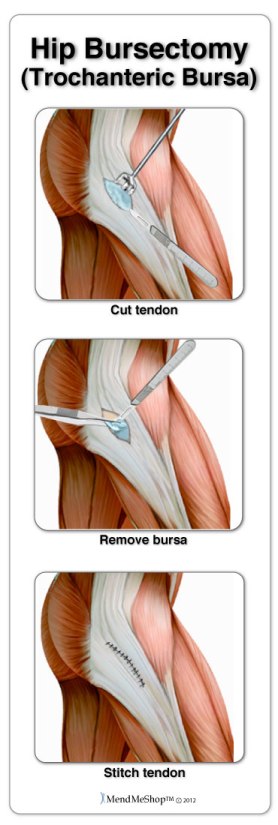 If your bursitis does not get better with conservative treatments, the bursa may be surgically removed. Usually this is done by hip arthroscopy, which is a surgical procedure where tiny incisions are made and a pencil-sized camera is inserted into the hip. A small shaver is inserted into another incision, and is used to remove the swollen bursa all together. The surgeon will then look for any damage to the hip and make repairs if necessary. This is also done to remove any bone spurs. Recovery time for the surgery will depend on a number of different factors including your healing ability, diet, rest and how many procedures were done in your surgery. Post-op recovery time can be minimized through the use of conservative treatment options such as rest, cold compression, stretching exercises, and the use of a TShellz Wrap® (after swelling is down) following surgery. Cold compression is recommend by doctors following surgery to treat your pain in a natural, non-addictive way and to reduce swelling. Once the incision has healed, speak with your doctor about the use of a TShellz Wrap®. The TShellz Wrap® is intended to encourage more oxygen and nutrients to flow to the area while improving soft tissue flexibility. Increased flexibility should help prevent and minimize the scar tissue that forms as you heal. Treating scar tissue is the most important step following surgery, especially in a joint, to improve the range of motion in your hip. Leaving the scar tissue untreated can lead to stiffness, chronic hip pain, osteoarthritis or other chronic conditions. Consistent exercise and conservative treatment on a daily basis during your rehabilitation while working with your doctor or physical therapist is key. This is why you should seriously consider maximizing your recovery by using the TShellz Wrap® at home once you are approved for PT. The more consistent you work at enhancing blood flow to surgically repaired soft tissue, the more consistent the healing process will be. Nourishing the tissues will more oxygen and nutrients (which are carried through the blood stream) will give the body a better ability to produce new, healthy collagen. In effect, you will help the body produce stronger tissues while potentially reducing the number of setbacks that can occur following surgical procedures. Rehabilitation Exercise for BursitisPT is a beneficial way to restore atrophied muscles and improve strength and mobility after treating bursitis. The type of PT and the duration will be dependent on the tissue damage and your symptoms. When you are treating or recovering from bursitis, it is important to ensure you do not perform any exercises that will further irritate the bursa. 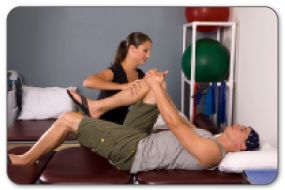 Once your pain starts to diminish, a physiotherapist will set up an individualized strengthening and stretching exercise program for you to perform at home or in the gym. This will be based on your needs and abilities, and will help you return to performing your normal routines. Individuals will often lift weights on their own, to try and build up their strength. However, in doing so, they can do more damage to their joint. It is extremely important to strengthen your muscles properly, as they may have weakened during the period of non-use. A trained therapist will help to ensure your rehabilitation process is appropriate and effective. For best, long term results use TShellz Wraps® at home, in conjunction with PT and an exercise program. Product Advisors are available 9:00 am to 5:00 pm Eastern Standard Time Monday to Friday. Learn More About Hip Joint Injuries & TreatmentsI want to learn more about Hip Surgery & Post-Surgery Recovery I want to learn more about Circulation Boost I want to learn more about Ice & Heat: Which Is Better For The Hip? I want to learn more about Trigger Points in the Hip I want to learn more about Hip Surgery: Do I Need It? During your recovery, you will probably have to modify and/or eliminate any activities that cause pain or discomfort at the location of your soft tissue injury until the pain and inflammation settle. Always consult your doctor and/or Physical Therapist before using any of our outstanding products, to make sure they are right for you and your condition. The more diligent you are with your treatment and rehabilitation, the faster you will see successful results! |
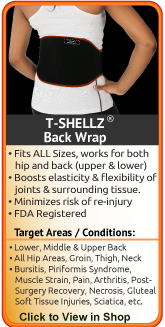       |

